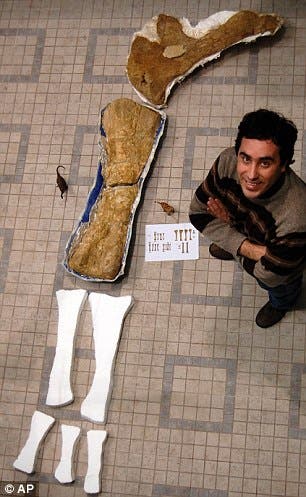
Octavio Mateus with part of a forelimb of the fossilised Angolitian adamastor, one of the largest creatures ever to walk on Earth.
In a recent remarkable find in the war-torn country of Angola, archeologists have uncovered the fossil of what’s considered a new, up till now unknown, dinosaur. The dinosaur has been appropriately been dubbed Angolatitan adamastor – Angolatitan means ”Angolan giant”, while the adamastor is a sea giant from Portuguese sailing myths.
A paper published on Wednesday in the Annals of the Brazilian Academy of Sciences describes a long-necked, plant-eating sauropod, among the largest creatures to have walked the earth, this although only one fossil was discovered, the forelimb bone. The fossil however features unique characteristics which is a conclusive factor which lead archeologists to confirm that this indeed is a new dinosaur.
Worth noting is the fact that the fossil was found along with fish and shark teeth in what would have been a seabed 90 million years ago. Regarding its discovery, the actual find was made in 2005 by PaleoAngola member Octavio Mateus of Portugal’s Universidade Nova de Lisboa and Museum of Lourinha. Since then excavations and research were completed and a paper was written for review by other scholar until finally this Wednesday the data could be published.
Matthew Bonnan, a sauropod expert at Western Illinois University, said he believes the team’s claim to have discovered a new dinosaur is genuine.
‘I think they’ve been very careful,’ he said, adding the find could add to knowledge about how sauropods – or lizard-hipped dinosaurs – adapted to different environments.
Dr Bonnan added it was ‘really cool’ to see research coming out of Angola.
‘The neat thing about dinosaur paleontology is that it’s becoming more global,’ he said.
‘The more people and places that we involve in science, the better off we all are,’ Dr Bonnan said.









